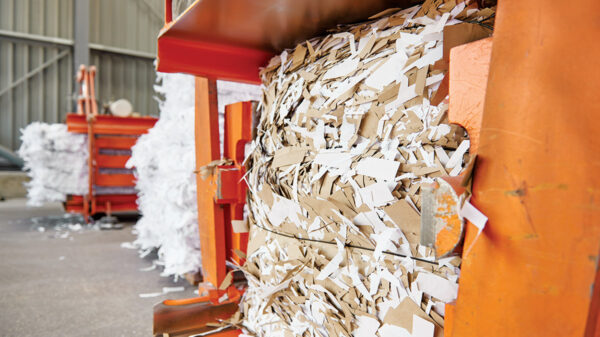Tariff policies are a bit of a moving target these days, clearly driven by political and economic factors. For the metal recycling industry, these tariffs introduce direct financial risks, as well as broader operational opportunities and challenges.
On February 10, 2025, President Donald Trump announced new, 25 percent tariffs on all imported steel and aluminum, effective March 2025. These tariffs eliminate prior exemptions and quotas, making them applicable to all U.S. trade partners. While the tariffs are framed as a measure to curb subsidized Chinese metal flooding global markets, they will affect Canada, Mexico, Brazil, South Korea, and the European Union (EU) more directly, as these nations are the top suppliers of steel and aluminum to the U.S.
“A critical point for the recycling industry is that ferrous and aluminum scrap remain excluded from these tariffs,” said Heewan Noh, a lawyer specializing in international trade and supply chain disruption issues at Huth Reynolds LLP. “The Recycled Materials Association confirmed after analyzing the executive orders that recycled steel and aluminum can continue to trade freely across U.S. borders without additional duties.”
Raul Munoz, national industry leader, mining and natural resources at Marsh, said that as the U.S. – Canada mineral trade faces increasing tariff challenges, and mining companies are under pressure to reassess supply chains, manage financial exposure and diversify trade relationships.
“The refining and manufacturing supply chains of Canada and the U.S. are deeply integrated, particularly around fundamental metals like aluminum and steel, and therefore very vulnerable to such tariffs,” Munoz said. “Automotive parts, for example, may move back and forth across the U.S.-Canada border up to eight times before a vehicle is ready to be sold. Another example is nickel – the only nickel mine in the U.S., the Eagle Mine in Michigan, has its nickel refined in Canada before going back to the U.S.”
Interestingly enough, recycled metals – including ferrous and nonferrous scrap – are notably exempt from these tariffs, allowing the flow of scrap materials to continue without additional duties.
“Despite this exemption though, the tariffs are already causing ripple effects throughout the metals and recycling industries, influencing pricing, demand dynamics, and trade relationships,” Munoz said.
The most immediate impact of the tariffs in the U.S. will be an increase in steel and aluminum prices, as imported metals become more expensive. According to Munoz, in 2024, Canada supplied one-fifth of all U.S. steel imports, while aluminum imports from Canada were even more significant, accounting for nearly 80 percent of all aluminum used in the U.S. that year.
“This will likely boost production at U.S. steel mills and smelters in the short term, but it could also lead to higher costs for manufacturers and industries reliant on metal inputs,” Munoz said. “Historically, when similar tariffs were imposed in 2018, the effects rippled across multiple sectors, increasing the cost of materials for manufacturers, raising prices for consumers, and ultimately leading to job losses rather than job creation. It is estimated that a 25 percent tariff on Canadian minerals could add over 11 billion in extra costs for U.S. manufacturers, which are then passed on to the consumers.”
Additionally, there is potential for retaliation from key trade partners, which could disrupt global supply chains and shift trade flows. Some buyers may look for alternative suppliers in non-tariffed countries, while others could explore greater use of recycled metals to mitigate cost increases.
Noh stressed that the immediate consequence of the tariffs will be higher costs for steel and aluminum imports, affecting industries that rely heavily on these materials, including automotive, aerospace, construction, packaging and oil and gas.
“U.S. manufacturers still rely on imports for certain specialized metal products, particularly steel pipes and tubes for oil drilling, and high-purity aluminum for aerospace and defense applications,” Noh said.
In addition, U.S. manufacturers import 40 percent of steel pipes and tubes needed for oil drilling. The new tariffs will raise costs for domestic energy production, potentially slowing down oil and gas development. And aluminum makes up 80 percent of aircraft weight, meaning the aerospace and defense sectors will see increased production costs.
“Car manufacturers use about half a ton of steel per vehicle – a 25 percent tariff could increase production costs by over $1,000 per car,” Noh said.
By raising input costs, Noh said the tariffs will put pressure on domestic industries that depend on these materials, making production more expensive.
“While U.S. steel and aluminum producers may see short-term gains from higher domestic prices, history suggests that these benefits will be offset by losses in manufacturing and other downstream industries,” Noh said. “In 2018, Trump’s steel tariffs caused U.S. steel prices to rise by about 2 percent, and imports fell by 25 percent, but the broader economy lost approximately 75,000 manufacturing jobs due to higher costs and retaliatory tariffs from trade partners. Additionally, aluminum-heavy industries, such as aerospace and beverage packaging, will also face increased expenses, which could lead to price hikes for consumers.”
Impact on Recycling Industry
Experts agreed that the metal recycling industry may experience mixed effects from these tariffs.
“On one hand, higher costs for primary metal could drive manufacturers to source more recycled content, increasing demand and potentially improving prices for scrap materials,” Munoz said. “This shift could particularly benefit U.S. recyclers, as companies seek domestic alternatives to offset higher import costs. On the negative side, recyclers reliant on equipment and components sourced from tariffed countries may see increased operational costs. Additionally, if tariffs lead to a slowdown in manufacturing or construction activity due to rising material costs, scrap generation could decline, affecting supply.”
Munoz recommended that exporters of scrap metal should also monitor potential retaliatory trade measures from countries affected by the tariffs. If major scrap-buying nations such as China, impose countermeasures, it could disrupt existing export markets.
Noh said that for the metal recycling industry, the impact of these tariffs will be mixed and will depend on how companies adjust to changing supply chains and pricing dynamics.
“On the positive side, the exclusion of ferrous and aluminum scrap from the new tariffs ensures that U.S. recyclers can continue exporting scrap metal without additional duties,” Noh said. “This could help sustain the international trade in recycled materials, preventing disruptions that could arise if major trading partners retaliated with restrictions on U.S. scrap imports.”
At the same time, recyclers may benefit from increased domestic demand for scrap metal, as manufacturers seek cheaper alternatives to imported raw materials. This could drive up scrap metal prices, creating new revenue opportunities for recycling firms.
“However, the extent of this benefit depends on whether domestic manufacturers have the capacity to absorb larger volumes of recycled metals,” Noh said. “Potential downsides include higher costs for recyclers that rely on imported semi-processed metals and increased operational expenses for processing and equipment manufacturers that use imported steel and aluminum components.” Furthermore, there is uncertainty regarding the reciprocal tariffs the administration is planning to impose on trading partners, which could have unintended consequences for scrap metal exports. If major markets like Canada, Mexico or the EU introduce new restrictions on U.S. recyclables, domestic recyclers could face oversupply issues and price volatility.
Danielle Spalding is the vice president of communications and public affairs at Cirba, a leader in battery recycling with 30+ years of experience, specializes in processing end-of-life batteries to recover critical materials for the U.S. supply chain.
According to Spalding, the current status of the proposed tariffs remains dynamic with many layers. As it stands, there is a direct impact on the recycling industry. This carries significant implications for both primary metal producers and the recycling sector.
“This could mean increased costs for raw materials and potential shifts in trade flows as global markets adjust,” Spalding said. “Companies in the recycling space need to closely monitor regulatory updates from the U.S. Trade Representative (USTR).”
Spalding further stressed that the new metal tariffs directly impact an estimated $50 billion in imports. She noted that once you put a tax on imported common goods, it is assumed that the price of the material used will be directly affected, with one big example being the automotive industry.
“However, the long-term impact on U.S. prices can be hard to predict as it is dependent on how manufacturers react,” Spalding said. “All of these implications show the importance of creating a strong, sustainable domestic supply chain when it comes to metals and others, including critical minerals. These materials already exist around us, so recycling them is an efficient way to increase domestic resilience and reduce our dependency on foreign sources. Additionally, it can improve our economy by increasing global competitiveness and job creation.”
Future Implications
For the metal recycling industry, in light of the proposed tariffs, the long-term trend is likely to favor increased utilization of recycled metals. Munoz said that whether through policy incentives, sustainability initiatives or cost-driven decisions, the demand for recycled content will continue to grow. This is a good thing for everyone in the long run – especially considering the growing demand as part of energy transition and electrification.
“While tariffs may create short-term disruptions, they also reinforce the value of a strong domestic recycling infrastructure as a hedge against volatile global trade conditions,” Munoz said.
Noh further noted that the future of these tariffs remains highly uncertain and depends on both political and economic factors. While some countries, including Australia, Japan, Brazil and South Korea have already begun seeking exemptions or quota-based agreements, there is no guarantee that the U.S. will grant relief.
“Given Trump’s previous tariff strategies, it is likely that some nations will negotiate trade deals in exchange for exemptions, but others may face prolonged disputes,” Noh said. “Retaliatory tariffs remain a serious possibility. Canada, the EU and Brazil have already indicated they are considering countermeasures, and the EU’s temporary truce on steel tariffs expires on March 31, which could lead to the reintroduction – and possible doubling – of retaliatory duties on U.S. goods. The political and economic implications of these tariffs could also lead to domestic pushbacks from industries struggling with rising costs.”
Furthermore, Noh said there is also the question of whether these tariffs will hold up under legal challenges.
“If manufacturing job losses become significant or inflation accelerates, the administration may face pressure to revise or roll back the tariffs,” Noh said.
Spalding noted that while tariffs are seen to increase the prices of materials, they could also incentivize domestic sourcing and production, ultimately strengthening our domestic metal supply chain.
“Ensuring materials remain accessible while keeping domestic industries competitive on a global scale will be essential to balance the impacts of these kinds of policies,” she said.
Published April 2025







